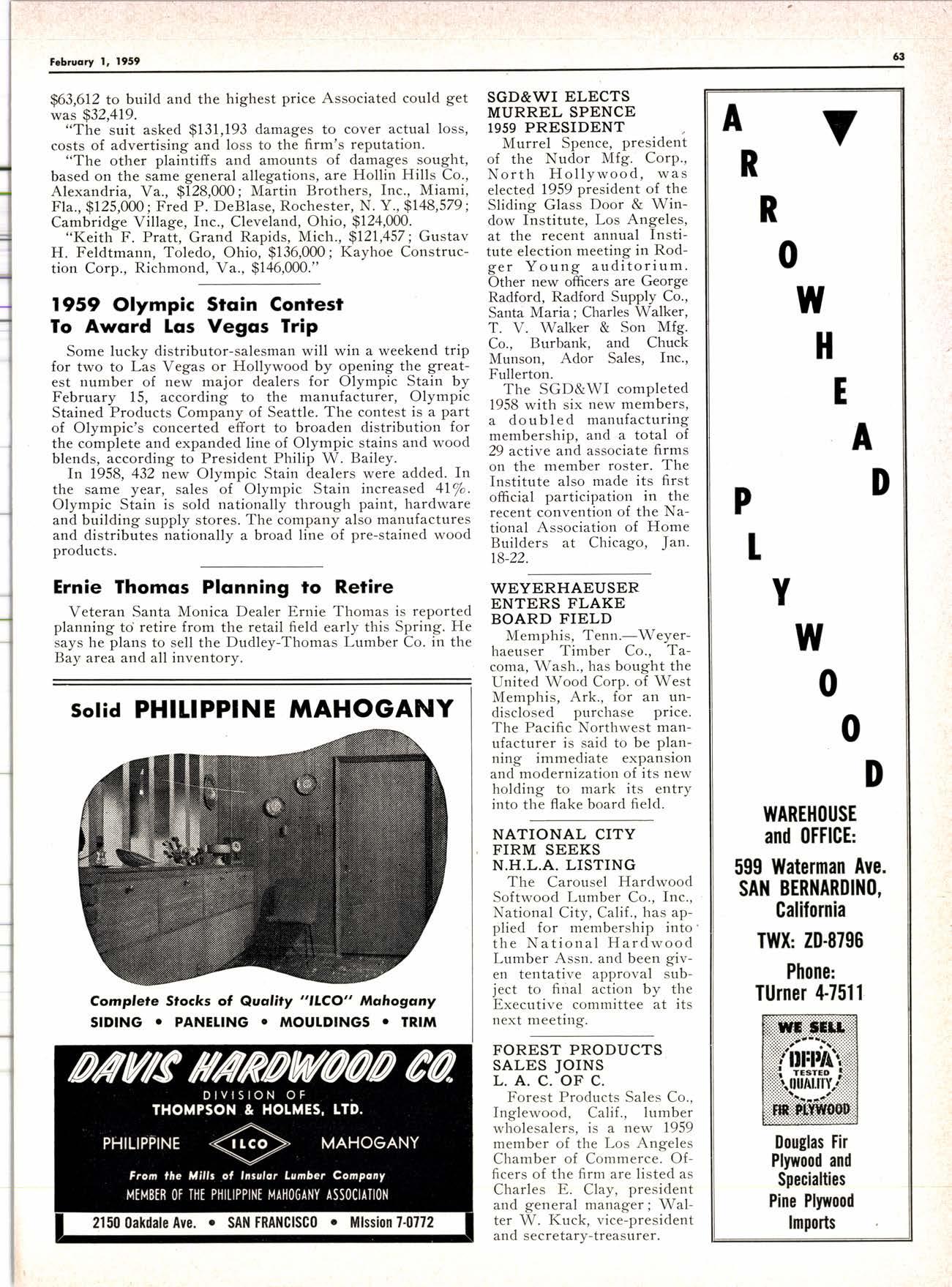
2 minute read
sO-Yqrd, 4-Stote Empire Cqrved in Lumber
(Rebrinted Courtesy of "This Earth"Kaiser Industries)
The year was 1895. The nation was beginning to flex'its economic rnuscles for the first time. Grover Cleveland was president and the first surges of the country's growing imperialistic sentiments were making themselves felt.
-F9r a youlg man in Fredericksburg, Iowa. it was a year of decision. His name was Joseph Copeland; the deciiion was to set rlp his own business-a retail lumber yard.
The results of that venture have spanned 63 years and been felt in seven states. Today the name Cope- land is affixed to one of the nation's largest retail lumber and building materials companies owned by one man.
It consists of 50 retail lumber yards spread over four statesOregon, Washington, California 1nd Nevada. A wholesale division, located at company headquarters in Portland, rounds out the picture.
The route by which one yard in Iowa grew to a halfhundred on the West Coast was a long and circuitous one. In 1912, after opening several more yaids, Joseph Copeland sold out and moved himself and family out to Idalio and finally to Montana, where he re-entereh the retail lumber business with a string of yards. In 1913 he moved onto the Oregon scene with incorporation there of Copeland Lumber Comoanv.
Soi 1. W "Joe" Copeland was put in as mallager of the company's first Oregon operation, the Lents yard on Portland's eastside. There the firm's present owner and president learned the business with stints as bookkeeper, yardman, even janitor. Soon he was ready to try his wirigs.
The senior Copeland helped his son start fis own companythe J. W. Copeland Yards. And the familiar story was again repeated : one yard led to two two to thre-e three to four . and in 1923 thg new firm was incorporated.
P:qth overtook Joseph Copeland in 1926. Young Joe quickly set to rvork consolidating the family interesti. He sold Copeland Lumber's Montana operations to Monarch Lumber Co. and made the remaining yards an affiliate organization of his J. W. Copeland Yards. Since then the only changes in the Copeland firm have been ones of steady growth.
Copeland Lumber today ranks as the oldest and biggest_lum_ber retailer in Oregon, among the largest in the Pacific Northwest. It employs nearly 300 employes, has assets in excess of $4,000,000.
_^Lum^be^r, naturally, is the biggest sale item . roughly 50,000,000 board feet a-year. Next biggest is wallboard, ptywood and the like . 20,000,000 feet a year (which includes a considerable volume of Kaiser Gypsum wallboard and insulating board plgducts). Third: hardware and paint.
The string of 50 yards (20 added since 1940)-is concen-

J. W. "Joc" COPEIAND (risht! it ownq qnd prcridant of the Rrm founded by hi! fothq in 1895. Al for lcft in bqnk of phot6 qt laft i! BUDDY DUNBAR, tho Copctdnd ofRcc nqnqger qnd rcond - in - c@mond. Cenlq ir H. B. SHAFER, purchoring ogenl, qnd, right, Oqdit Mqnoger DON GRAHA^4, qnothar of th€ xoy mq in Copelond orgqnizolion trated most heavily in Oregon, where there are 31. There are nine in California, seven in Washington, and three in Nevada. The city of Portland itself accorints for five of the Oregon total. The wholesale division, Copeland Wholesale Co., has its warehouse at company headquarters in downtown portland. 'l'he warehouse boasts 40,000 sq. ft. of storage area. Man_ ag_e-r of the rvholesale_company is goU Chapman.
DOUGTAS FIR REDWOOD ond FIR PLYWOOD
o Sluds, Boqrds o Dimengion Lumber o Plqnks, fimbers o Rqilroqd Ties o Industriol Cuilings

![BONNINGTON LI]DIBBB OO.](https://assets.isu.pub/document-structure/230727201647-e018b83b14248a9d6490fd9e237f3f12/v1/114f9eff88a705bf7440406fb181c718.jpeg)








